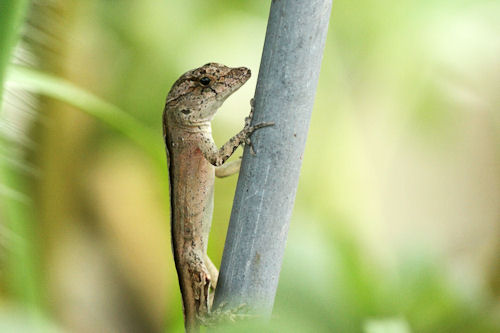Juvenile Anolis aquaticus wakes up for science, Photo: Jonathan Flanders
One of the many wonderful things about anoles is that anole-hunting can be a 24/7 experience, as many nocturnal Anole Annals adventurers have shown and I’ve noted before. As an undergraduate, I spent many days and nights scanning trunks, leaves, sticks, bushes, etc. for anoles — a habit that got so ingrained that I still do it while hiking around northern California. So, logically, when I found myself in Costa Rica for the last field season of my Ph.D. (which is on bats), I had to do some lizard spotting, if only to remind myself of the good old days when I studied animals that don’t fly or bite. (Ok, anoles bite but that’s what makes them such great fashion accessories.) As I was already up until all hours of the night, I decided to check out where anoles were sleeping. There happened to be a small group of aquatic anoles living near my cabin and I (along with my batty colleague) noticed that each night they seemed to be in the same place — one email to Jonathan later and we wrote up a short note for Herpetological Review about sleep site fidelity in Anolis aquaticus.
We observed the lizards for 16 nights over a period of 24 nights and found that of the six individuals, they were in the same place almost 80% of the nights, which is very high compared to what has been found in some other species. All of the lizards were perched in such a way that they were either obscured from view or had easy access to water to escape from predators. The area was particularly dry at that time so this may have reduced the number of suitable sleep sites for these aquatic lizards or maybe aquatic anoles are just pretty faithful to their sleep sites. In any case, it was a lot of fun to go back to my lizard-y roots and find some sleepy anoles.




















